Salt in our tears and other thoughts
Pan de sal, the Filipino breakfast and merienda staple—with palaman or without—was the first to pop up in my mind. (Sal is Spanish for salt.) Next was the biblical saying on becoming “the salt of the earth” and what that entailed. Then the saying “back to the salt mines.”
Troubled by recent reports that our archipelagic home floating between azure sky and azure sea, the so-called Pearl of the Orient, could soon be short of salt (sodium chloride or NaCl), I posted on a chat group that I was writing this column titled the above—salt in our tears. I was just heaving a sigh of disbelief.
A friend of gentle spirit sent a swift reply aimed at the solar plexus: “How do we extract salt from our tears? If we can do that, perhaps there will be sufficient salt because of the amount of tears that have flowed from the poor, the needy, the oppressed, the Red-tagged, and from those who’ve had untimely deaths among them. We have so much sea water around us and we’re running out of salt? Totoo ’yan, yung iba nga naubos na ang luha (It is true that some have no more tears.)”
Indeed, it is the irony of ironies. Some years back, it was garlic, then rice and galunggong fish, and recently, white onions, then sugar, and now salt that will be hard to come by if not more expensive. Often, the knee-jerk reaction is to import. (Haven’t we learned from imported cheap rice and the tariffication move that would drive farmers to penury?)
But sadly, the Philippines has been importing staples for our tables, rice specifically, which had been this country’s main produce in centuries past. Decades ago, so many Thais were studying here to become top-notch agriculturists in their home country. Now, Thailand is one of our sources of imported rice, while Vietnam, whose countryside had been practically rendered infertile with napalm bombs and Agent Orange by US forces, has risen from the ashes of war to become a rice-exporting country.
Our agricultural country now imports food that we ourselves could grow or produce. Why? While salt is not food per se, it is a food additive and preservative, an ingredient for many purposes, among them culinary, industrial, agricultural, even medical and pharmaceutical. It is even used for cloud seeding to make rain.
On the culinary side, less salt could mean healthier eating for the hypertensive, which is the same in the case of sugar for the diabetics. But that is another story.
So while the Senate was investigating whether or not the importation order for sugar was official and legit, and whether or not there is a real sugar shortage, salt suddenly dashed from behind to call attention.
If ours is indeed a valley of tears, as my friend imagines our country to be, then we should figuratively be swimming in salt. Tears are salty because salt, in some form, is present in our tears. Any ophthalmologist will tell you that. That is as far as the metaphor goes. Not to forget that we are physically and literally right smack in the Pacific Ocean, where our tears from the valley blend with the wide blue expanse from which we can extract mountains of salt to flavor our lives without importing.
There are fancily named imported salt in select groceries. “Artisanal,” they are called—pink Himalayan, kosher, etc. While ours are simply labeled “Fidel-ized,” meaning iodized. Fidel stands for “fighting iodine deficiency law.” I am told that this was a setback for some small salt producers who did not have the iodizing know-how and gave up their backyard livelihood for something else.
When I visited Pangasinan months ago, I went to the market (as I am wont to do when I go places) to buy takal salt, un-iodized. So did my friends. Most backyard salt making in Pangasinan are done by boiling sea water, which has natural iodine in it.
By the way, the famous Salt Spring of Nueva Viscaya of Geography class is no more, the result of geological changes. I was a child when I saw for the first time a rock of mineral salt called tultul which, I was told, flavored the rice when food was scarce during the Japanese occupation. I remember seeing from the car window the wide expanse of white gleaming in the sun like snow, the small human figures with wooden rakes slowly disappearing from view. Those were the salt beds and salt makers of yesteryears.
—————-
Send feedback to cerespd@gmail.com





















